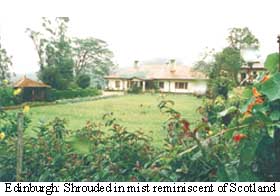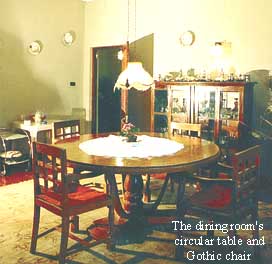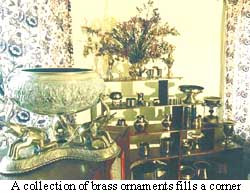

![]()
 From
the outside, the Edinburgh plantation bungalow is nothing to write home
about. It is one of the crop of bungalows that sprouted in the Nuwara Eliya
district in the 1930s, replacing older buildings with utilitarian designs.
Seen on a damp morning it looks rather dismal, perhaps like its counterparts
in the suburbs of Scotland's Edinburgh.
From
the outside, the Edinburgh plantation bungalow is nothing to write home
about. It is one of the crop of bungalows that sprouted in the Nuwara Eliya
district in the 1930s, replacing older buildings with utilitarian designs.
Seen on a damp morning it looks rather dismal, perhaps like its counterparts
in the suburbs of Scotland's Edinburgh.
Nanu Oya, where the Edinburgh bungalow is located at 5,500 feet above sea level, is frequently shrouded in mist. There is a grand view of the plantation hills clad in tea as the train to Badulla curves around the countryside on its approach to the Nanu Oya railway station which itself dates from 1885.There is a rail bridge over twin waterfalls on the estate and a crispness in the air at odds with its location only six degrees from the equator.
Doubtless the misty scenery of bends and glens was what inspired a Scottish planter there to name his estate after his home town in Scotland. But plantation labourers who came from southern India also recognised it as being like home. To them, the Edinburgh (pronounced Edinboro) plantation was known as Nilgiri Totum, recalling the equally misty hills and dales of that tea growing district of Tamil Nadu.
Naturally the expectation when seeing the Edinburgh bungalow from its large lawn, is of a warm interior since chimneys protrude from its red-painted roof. Actually the exterior does not give a clue to the elegance within. This is heightened by the purchases at auction of furniture and knickknacks by its occupant, planter Geoffrey Miles and his wife Gail.
Both come from planting backgrounds and this shows their enthusiasm for furniture and glass and antiques that suit the bungalow and add the traditional planter touches. One of the advantages of bungalow living is that rooms are large enough for big pieces of furniture; modern homes can scarcely cope with large wardrobes and family-size dining tables.
 The
dining room at Edinburgh is one of a suite of three rooms, all of which
share a chimney, with a fireplace in each. In the dining room the fireplace
is wedged into a corner and the table is circular.The chairs have been
made to a design that shows a Gothic influence with high heels and broad
latticed backs. The kitchen is far from the dining room, in a separate
house, as were the kitchens of bungalows of the last century.
The
dining room at Edinburgh is one of a suite of three rooms, all of which
share a chimney, with a fireplace in each. In the dining room the fireplace
is wedged into a corner and the table is circular.The chairs have been
made to a design that shows a Gothic influence with high heels and broad
latticed backs. The kitchen is far from the dining room, in a separate
house, as were the kitchens of bungalows of the last century.
The morning room, with another wedge of fireplace in its corner, adjoins the dining room while the main sitting room runs the length of the two rooms and has its fireplace in the centre of the shared wall. Utilitarian indeed.
 The
room has been turned into a veritable treasure trove with the personal
possessions of Mr. & Mrs. Miles. Like many people with a planting background,
they have a weakness for brass ornaments. It would be difficult to imagine
how a collection assembled so lovingly could be kept permanently shining
bright without the servants who go with a plantation home.
The
room has been turned into a veritable treasure trove with the personal
possessions of Mr. & Mrs. Miles. Like many people with a planting background,
they have a weakness for brass ornaments. It would be difficult to imagine
how a collection assembled so lovingly could be kept permanently shining
bright without the servants who go with a plantation home.
Plantation artefacts include an old tea boiler and a patent stove and other items like a musical beer mug collected during a lifetime of planting.
The gloomy aspect of Edinburgh's exterior is contradicted by the lively warmth within it. The floors of the bungalow which are all of red tiles help but it is the personal possessions of the occupants that give the Edinburgh bungalow a charm that those who live in similar houses in Scotland - or in Tamil Nadu - would envy.-
Continue to Plus page 6 * Preaching the pirith power * Murals in a mess
Return to the Plus contents page
![]()
| HOME PAGE | FRONT PAGE | EDITORIAL/OPINION | NEWS / COMMENT | BUSINESS
Please send your comments and suggestions on this web site to
info@suntimes.is.lk or to
webmaster@infolabs.is.lk